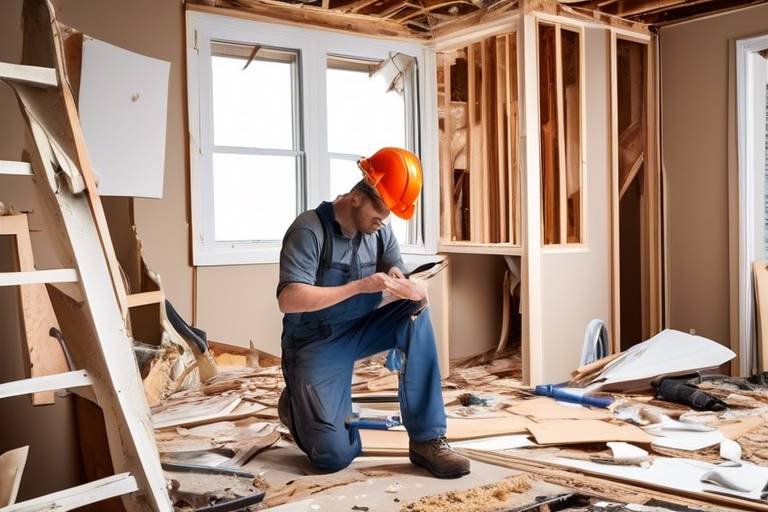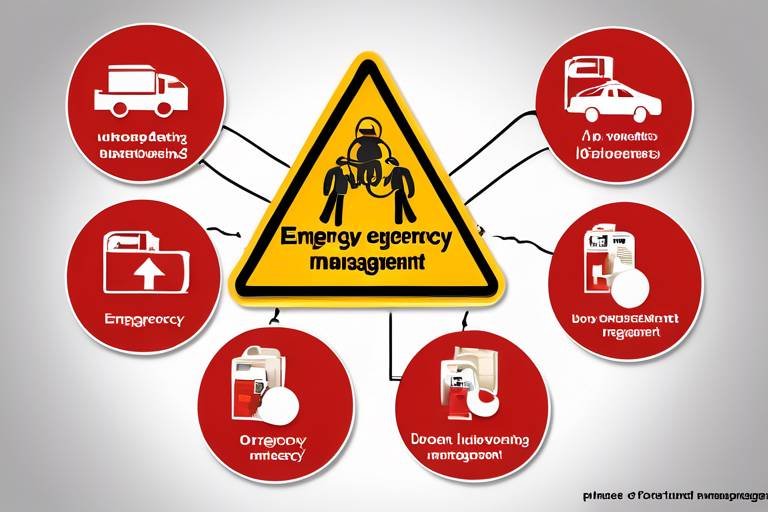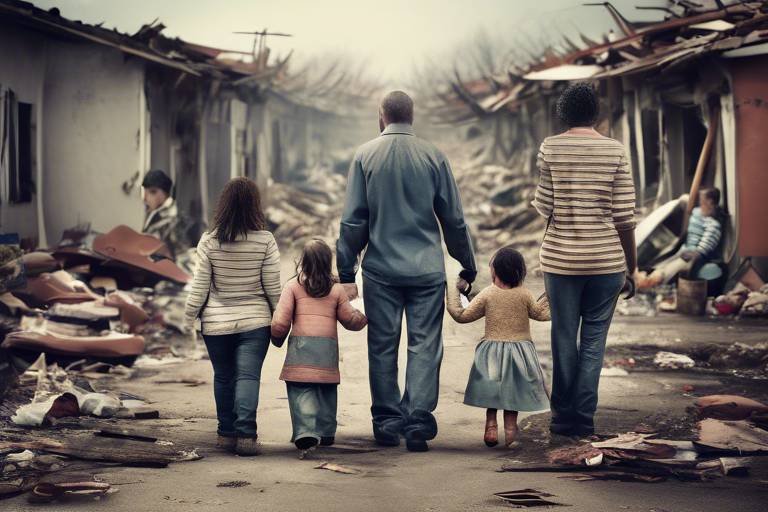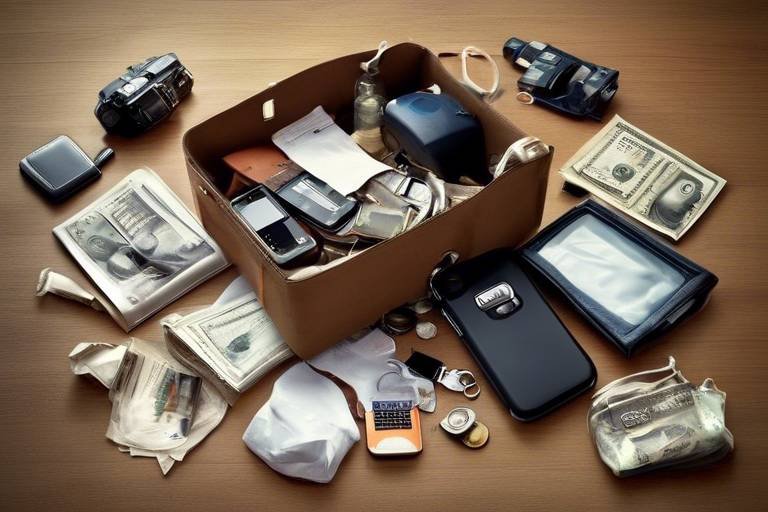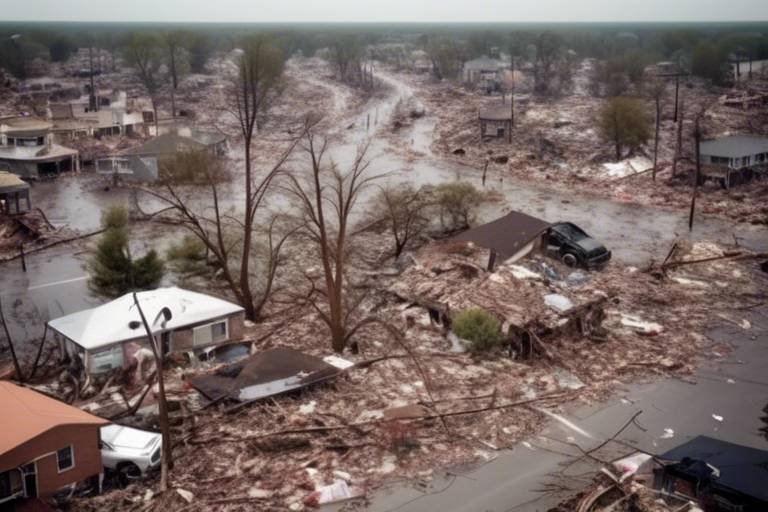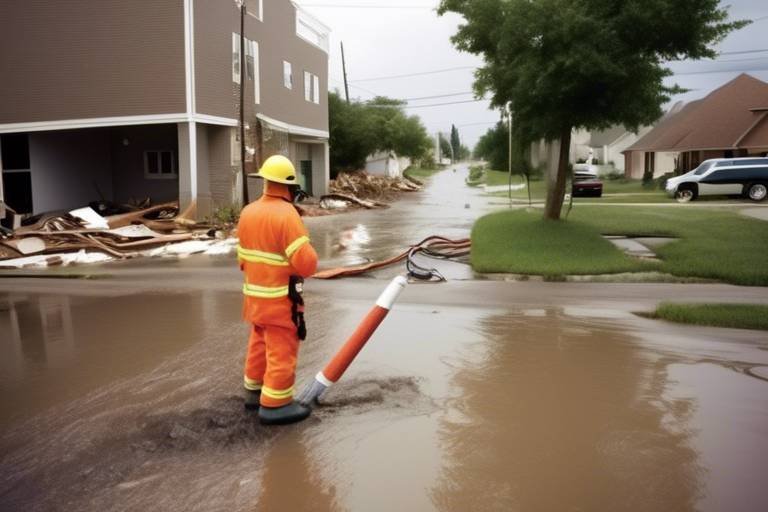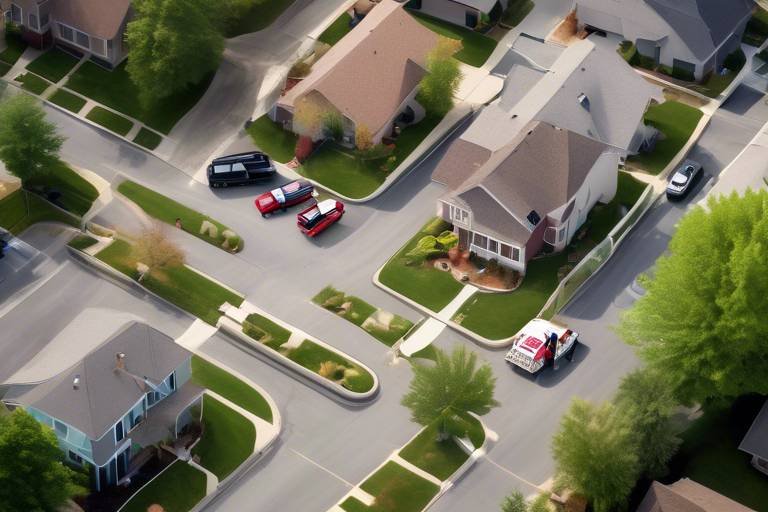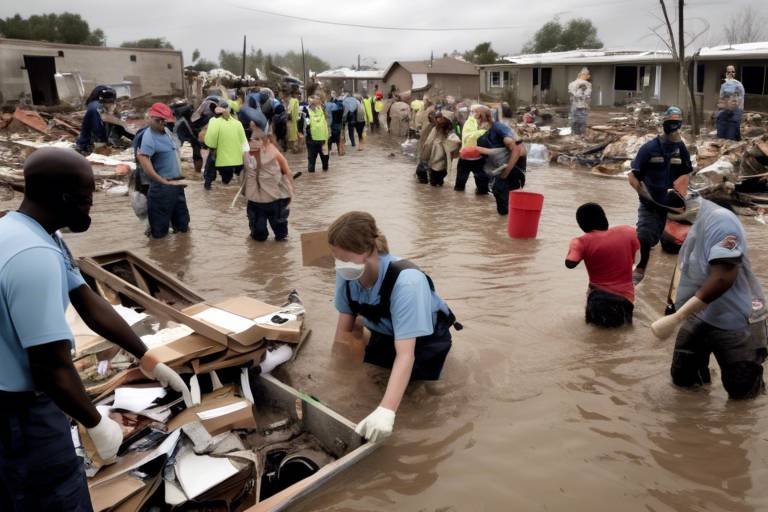Hosting a Community Workshop on Disaster Preparedness
In today's unpredictable world, the importance of disaster preparedness cannot be overstated. Hosting a community workshop on this vital topic is not just a good idea; it's a necessity. Imagine a scenario where a natural disaster strikes—do you think your community is ready? By organizing a workshop focused on disaster preparedness, you can equip your neighbors with the knowledge and skills they need to respond effectively in emergencies. This article will guide you through the essential elements of planning such a workshop, emphasizing the significance of education, collaboration, and practical strategies to enhance community resilience.
Disaster preparedness involves proactive measures to mitigate risks and respond effectively to emergencies. It’s like having a safety net when you’re walking a tightrope; you hope you never fall, but if you do, you'll be glad it’s there. The fundamentals of disaster preparedness encompass understanding the different types of disasters—natural or man-made—and knowing how to react to them. This knowledge is crucial because it can mean the difference between chaos and calm in a crisis. By fostering a culture of preparedness, communities can safeguard lives, property, and the environment.
Before you dive into organizing the workshop, it's essential to assess the specific needs of your community. Think about it: if you were to host a cooking class, you wouldn’t just serve sushi to a group that prefers pizza. Similarly, understanding what your community needs in terms of disaster preparedness ensures that the workshop is relevant and engaging. You can gather insights through surveys, community meetings, or even informal conversations. This way, the workshop will address the most pressing concerns, making it a valuable experience for all participants.
Selecting an appropriate venue for the workshop can significantly influence its success. The location should be accessible to everyone—think about public transport options and parking availability. Comfort is also key; a cozy, inviting space encourages participation. Consider venues like community centers, schools, or even local parks. The atmosphere should be conducive to learning, allowing participants to feel relaxed and open to engaging with the material and each other.
Inviting knowledgeable speakers can transform your workshop from good to great. Imagine having a seasoned emergency management professional or a local firefighter share their experiences and insights. Their expertise not only adds credibility but also provides participants with real-world applications of disaster preparedness strategies. When selecting speakers, look for individuals who can communicate effectively and are passionate about the topic. Their enthusiasm can be contagious, inspiring attendees to take action in their own lives.
Interactive activities are the secret sauce for a successful workshop. They promote engagement and help participants retain information more effectively. Consider incorporating hands-on exercises like emergency kit demonstrations or role-playing scenarios where participants practice their response to a disaster. These simulations can make the learning experience memorable and impactful, allowing attendees to walk away with practical skills they can apply in real-life situations.
Effective marketing strategies are essential for attracting participants to your workshop. Think of it as throwing a party; you want everyone to know about it! Utilize social media platforms, create eye-catching flyers, and reach out to local organizations for partnerships. Word-of-mouth is powerful, so encourage participants to bring friends and family. The more people you can engage, the greater the impact your workshop will have on the community.
After the workshop, it’s vital to evaluate its success. Gathering feedback from participants can provide insights into what worked well and what could be improved. Consider using surveys or informal discussions to collect this information. This feedback loop is crucial for enhancing future workshops and ensuring ongoing community engagement. Remember, the goal is to create a sustainable culture of preparedness, and continuous improvement will help you achieve that.
Establishing a network for ongoing support and resources is critical. Think of it as creating a safety net for your community. After the workshop, encourage participants to stay connected through social media groups, email newsletters, or regular meet-ups. This fosters connections among participants, agencies, and organizations, promoting continuous learning and collaboration in disaster preparedness. A strong network can be a lifeline in times of crisis, ensuring that community members have access to the resources they need.
Providing additional resources enhances participants' knowledge and preparedness. After the workshop, share valuable materials, websites, and organizations that offer further information and support in disaster preparedness initiatives. This could include links to FEMA, local emergency management agencies, or online courses. The more informed your community becomes, the better equipped they will be to handle emergencies.
Q: What is the best way to prepare for a disaster?
A: The best way to prepare is to have an emergency kit, a communication plan, and knowledge of local hazards.
Q: How often should we conduct disaster preparedness workshops?
A: Regular workshops, at least once a year, help keep the community informed and prepared.
Q: Can children participate in disaster preparedness workshops?
A: Absolutely! Involving children helps instill important safety habits from a young age.

Understanding Disaster Preparedness
This article explores the essential elements of organizing a community workshop focused on disaster preparedness, emphasizing the importance of education, collaboration, and practical strategies to enhance community resilience.
Disaster preparedness is not just a buzzword; it's a crucial lifeline that can save lives and protect property when the unexpected strikes. Imagine waking up one day to find your community facing a natural disaster—be it a hurricane, earthquake, or flood. The chaos that ensues can be overwhelming, but with proper preparedness, individuals and communities can navigate through the storm with confidence. So, what exactly does disaster preparedness entail? It involves a series of proactive measures designed to mitigate risks and ensure effective response during emergencies.
The significance of disaster preparedness cannot be overstated. It empowers communities to respond swiftly and effectively, reducing the overall impact of disasters. By developing a well-thought-out plan, individuals can safeguard their families, homes, and neighborhoods. Here are some fundamental aspects of disaster preparedness:
- Risk Assessment: Understanding the specific risks that your community faces is the first step. Are you in a flood zone? Is your area prone to wildfires? Identifying these risks allows you to tailor your preparedness efforts accordingly.
- Emergency Plans: Creating a comprehensive emergency plan is essential. This plan should include evacuation routes, communication strategies, and designated meeting points for families and neighbors.
- Resource Management: Stockpiling essential supplies—like food, water, first aid kits, and medications—ensures that you are prepared for any situation. It's like having an insurance policy that you can rely on when times get tough.
Moreover, disaster preparedness fosters a sense of community resilience. When individuals are educated and equipped to handle emergencies, they can support one another more effectively. It’s a bit like a well-oiled machine; every part needs to function correctly for the whole to succeed. This collaborative spirit can be further enhanced through community workshops, where members can share knowledge, resources, and experiences.
In summary, understanding disaster preparedness is about more than just having a plan in place; it's about cultivating a culture of readiness within your community. By educating ourselves and others, we enhance our ability to respond to emergencies, ultimately leading to a safer, more resilient community. So, as we move forward in this article, let’s delve deeper into how to effectively prepare for a workshop that addresses these critical issues.
Q: What is disaster preparedness?
A: Disaster preparedness involves planning and taking proactive measures to mitigate risks and respond effectively to emergencies.
Q: Why is community involvement important in disaster preparedness?
A: Community involvement fosters collaboration and ensures that everyone is informed and ready to respond, enhancing overall resilience.
Q: How can I assess the risks in my community?
A: You can start by researching local hazards, consulting with emergency management agencies, and participating in community risk assessments.
Q: What are some essential supplies to have in a disaster preparedness kit?
A: A disaster preparedness kit should include water, non-perishable food, a flashlight, batteries, a first aid kit, medications, and important documents.
Q: How can I get involved in local disaster preparedness efforts?
A: You can volunteer with local organizations, attend community workshops, and participate in training sessions to learn more about disaster readiness.

Identifying Community Needs
When it comes to hosting a successful community workshop on disaster preparedness, the first step is understanding the unique needs of your community. This isn't just about throwing together a few slides and hoping for the best; it’s about diving deep into what really matters to the people who will be attending. Think of it as crafting a tailored suit rather than buying something off the rack. Each community has its own set of challenges, resources, and dynamics, and recognizing these factors will set the stage for a workshop that resonates.
One effective way to identify community needs is through a combination of surveys and focus groups. Surveys can be distributed online or in person, allowing residents to express their concerns and priorities regarding disaster preparedness. Questions might include:
- What types of disasters are you most concerned about?
- What resources do you currently have in place?
- What areas do you feel need more education or training?
Focus groups can provide deeper insights, allowing participants to discuss their experiences and needs in a more interactive setting. This method not only uncovers specific needs but also fosters a sense of community, as residents share their stories and learn from one another. By engaging in these discussions, you can identify common themes and issues that should be addressed during the workshop.
Additionally, collaborating with local organizations, such as schools, community centers, and emergency services, can provide valuable perspectives. These entities often have firsthand knowledge of the community's vulnerabilities and can help pinpoint areas that require immediate attention. For example, a local fire department may highlight the need for fire safety education, while a school might emphasize the importance of teaching children how to react in emergencies.
Another crucial aspect to consider is the demographic makeup of your community. Different age groups, cultural backgrounds, and socioeconomic statuses can influence how people perceive and prepare for disasters. Tailoring your workshop content to address these diverse needs will not only enhance engagement but also ensure that everyone feels included and empowered. For instance, younger audiences may respond better to interactive simulations, while older participants might appreciate more traditional presentations.
In summary, identifying community needs is not a one-size-fits-all approach. It requires a proactive and inclusive strategy that takes into account the unique characteristics of your community. By utilizing surveys, focus groups, and collaboration with local organizations, you can gather the insights necessary to create a workshop that is both relevant and impactful. Remember, the goal is to foster a culture of preparedness, and understanding the specific needs of your community is the first step in making that happen.
Q: Why is it important to identify community needs before the workshop?
A: Identifying community needs ensures that the workshop addresses relevant concerns and engages participants effectively, making it more likely that they will take away valuable information.
Q: How can I gather information about community needs?
A: You can use surveys, focus groups, and collaborate with local organizations to gather insights about the specific needs and concerns of your community.
Q: What if my community has diverse demographics?
A: Tailoring your workshop content to address the diverse needs of different age groups, cultural backgrounds, and socioeconomic statuses will enhance engagement and ensure inclusivity.
Q: Can I use online tools to conduct surveys?
A: Absolutely! Online survey tools like Google Forms or SurveyMonkey can make it easy to distribute surveys and collect responses efficiently.

Choosing the Right Venue
When it comes to hosting a successful community workshop on disaster preparedness, the venue you choose can make all the difference. Think of it as the stage for a performance; if the setting isn’t right, even the most talented actors can’t shine. So, what should you consider when selecting the perfect location? Let’s dive into some critical factors that will help you make an informed decision.
First and foremost, accessibility is key. You want to ensure that everyone in the community can easily reach the venue. Consider factors like public transportation options, parking availability, and whether the location is wheelchair accessible. Imagine if someone in your community, eager to learn about disaster preparedness, is unable to attend simply because they couldn’t find a parking spot or navigate the building’s entrance. That’s a missed opportunity!
Next, think about the size of the venue. It should comfortably accommodate your expected number of participants while also allowing for some space to move around. A cramped room can stifle engagement and make it difficult for attendees to interact with each other and the presenters. On the flip side, a venue that’s too large may feel empty and uninviting. Aim for a space that strikes the right balance, perhaps a local community center or school auditorium that can be easily configured for your needs.
Another vital aspect is the comfort of the venue. This includes seating arrangements, lighting, and even temperature control. A comfortable environment helps participants stay focused and engaged. Consider whether the seating is flexible enough to allow for group discussions or activities, and ensure that the room has adequate lighting for presentations and visibility. If possible, visit the venue beforehand to get a feel for the space and make any necessary adjustments.
Let’s not forget about the availability of technology. In today’s world, many workshops incorporate multimedia presentations, and having the right tech setup can enhance the learning experience. Check if the venue has a projector, sound system, and Wi-Fi access. It’s also wise to have a backup plan in case of technical difficulties. After all, you wouldn’t want your workshop to be derailed by a malfunctioning projector!
Finally, consider the atmosphere of the venue. The environment should be welcoming and conducive to learning. Look for spaces that reflect a sense of community, perhaps decorated with local artwork or photos that resonate with the participants. A warm and inviting atmosphere can encourage attendees to engage more openly, fostering a sense of connection and collaboration.
In summary, choosing the right venue is a multifaceted decision that requires careful consideration of accessibility, size, comfort, technology, and atmosphere. By taking the time to evaluate these factors, you can create an inviting and effective space for your community workshop on disaster preparedness, ensuring that it is not only informative but also memorable.

Engaging Expert Speakers
When it comes to hosting a community workshop on disaster preparedness, one of the most impactful decisions you can make is selecting the right expert speakers. Imagine walking into a room filled with eager participants, all eyes on a knowledgeable speaker who not only conveys critical information but also captivates the audience with engaging stories and real-life experiences. This is the kind of atmosphere you want to create, and it all starts with the right choice of speakers.
First and foremost, you want to look for individuals who have a strong background in disaster preparedness. This could include professionals like emergency management officials, first responders, or even community leaders who have successfully navigated disaster situations in the past. Their firsthand experiences can provide invaluable insights that textbooks simply can't offer. Have you ever heard a story that made you feel like you were right there in the moment? That's the kind of impact a good speaker can have.
Moreover, it’s essential to consider the diversity of expertise among your speakers. By bringing together a range of voices—from medical professionals discussing health and safety during disasters to local government officials explaining emergency protocols—you create a well-rounded educational experience. This diversity not only enriches the content but also ensures that different aspects of disaster preparedness are covered, making it relevant for everyone in attendance.
Another critical factor is the speaker's ability to engage the audience. Look for speakers who are not just knowledgeable but also personable. They should be able to connect with the audience, encouraging questions and discussions. You might ask yourself, "How can I ensure the speaker is engaging?" One way is to request a sample of their previous presentations or seek feedback from others who have attended their talks. A dynamic speaker can make a dry topic come alive, transforming complex information into something relatable and actionable.
It’s also beneficial to include interactive elements in your speaker sessions. For instance, consider asking speakers to incorporate Q&A segments or hands-on demonstrations. This not only breaks the ice but also allows participants to apply what they’re learning in real-time. Imagine a scenario where participants can practice CPR techniques or learn how to create an emergency kit right then and there—these hands-on experiences can solidify the knowledge gained during the workshop.
Finally, don’t underestimate the power of follow-up. After the workshop, provide participants with a way to connect with the speakers, whether through social media, emails, or community forums. This ongoing relationship can foster a sense of community and encourage participants to continue learning about disaster preparedness. Remember, the goal is not just to inform but to inspire action and collaboration within your community.
In summary, engaging expert speakers is a cornerstone of a successful disaster preparedness workshop. By selecting knowledgeable, relatable, and dynamic individuals, you can create an environment that not only educates but also empowers your community to take proactive steps in disaster readiness.
Q: How do I find expert speakers for my workshop?
A: Start by reaching out to local emergency management agencies, fire departments, and universities. Networking within your community can also lead you to knowledgeable individuals.
Q: What qualifications should I look for in a speaker?
A: Look for speakers with practical experience in disaster response, relevant certifications, and a track record of engaging presentations.
Q: Can I have multiple speakers at my workshop?
A: Absolutely! Having a variety of speakers can provide diverse perspectives and keep the audience engaged.
Q: How can I ensure the speakers are engaging?
A: Request samples of their previous work, check reviews, and ask if they can include interactive elements in their presentations.

Creating Interactive Activities
When it comes to hosting a community workshop on disaster preparedness, the key to keeping participants engaged lies in interactive activities. Think about it: how many times have you sat through a lecture, only to zone out halfway through? That's why incorporating hands-on experiences is crucial. It’s not just about listening; it’s about doing. By actively involving participants, you can ensure that they absorb the information more effectively and feel more prepared for real-life situations.
One effective way to create interactive activities is through simulations. For instance, you could set up a mock disaster scenario, like an earthquake or a flood, where participants must work together to respond appropriately. This could involve practicing evacuation routes, setting up emergency kits, or even conducting a headcount. Simulations can be incredibly enlightening, as they allow participants to experience the chaos of a disaster in a controlled environment, helping them to understand the importance of quick thinking and teamwork.
Another engaging activity is the hands-on workshop where participants can build their own emergency kits. You can provide a list of essential items—such as water, first-aid supplies, and non-perishable food—and let participants assemble their kits. Not only does this teach them what to include, but it also gives them a tangible takeaway. Imagine the pride they’ll feel walking away with a kit they put together themselves! Plus, you can encourage them to personalize their kits based on their unique family needs, which makes the experience even more relevant.
Incorporating group discussions can also enhance the interactive nature of your workshop. Divide participants into small groups and present them with specific disaster scenarios. Ask them to brainstorm solutions and then share their ideas with the larger group. This not only fosters collaboration but also allows participants to learn from each other’s perspectives and experiences. It’s amazing how much knowledge can be exchanged in a short amount of time when people feel comfortable sharing their thoughts.
Don’t forget to include some fun yet educational games! For example, you could create a trivia game focused on disaster preparedness facts. Use a quiz format where participants can compete in teams, and offer small prizes for the winners. This not only makes learning enjoyable but also reinforces important information that they might need to remember during an actual emergency.
Lastly, consider utilizing technology to enhance the interactivity of your workshop. You could incorporate mobile apps that provide disaster preparedness tips or even use virtual reality (VR) to simulate disaster scenarios. While VR might require a bit more investment, the level of engagement it offers can be truly transformative. Participants will be talking about their experiences long after the workshop ends!
In summary, the goal of creating interactive activities is to ensure that participants leave feeling informed, empowered, and ready to take action. By incorporating simulations, hands-on workshops, group discussions, games, and technology, you’re not just teaching them about disaster preparedness; you’re equipping them with the skills and confidence they need to handle emergencies effectively.
- What types of disasters should we focus on in the workshop? It's best to tailor your content to the specific risks faced by your community, such as earthquakes, floods, or wildfires.
- How can we encourage more people to attend? Utilize social media platforms, community bulletin boards, and local organizations to spread the word about your workshop.
- What age groups should we target? Aim for a diverse audience, including families, seniors, and local businesses, to ensure comprehensive community preparedness.

Marketing the Workshop
When it comes to hosting a successful community workshop on disaster preparedness, effective marketing is key. Think of it as the foundation of your workshop—without it, everything else might crumble. You want to ensure that your message reaches the right audience and that they feel compelled to join. So, how do you spread the word and attract participants? Let's dive into some strategies that can make your workshop the talk of the town!
First off, leveraging social media is a powerful way to connect with your community. Platforms like Facebook, Twitter, and Instagram allow you to share engaging content about your workshop. Create eye-catching graphics and post regularly to keep your audience informed and excited. Don't forget to use relevant hashtags to increase your visibility! You can even create an event page where people can RSVP, ask questions, and share the event with their friends.
Another effective method is to distribute flyers in local businesses, community centers, and schools. A well-designed flyer can capture attention quickly. Make sure to include essential details such as the date, time, location, and a brief description of what attendees can expect. You might also consider offering an incentive, like a free emergency kit or a discount on future workshops, to encourage sign-ups. Here’s a simple structure you can follow:
| Element | Description |
|---|---|
| Date & Time | Clearly state when the workshop will take place. |
| Location | Provide the address and any specific directions if necessary. |
| Workshop Highlights | Briefly mention the key topics that will be covered. |
| Contact Information | Include a phone number or email for inquiries. |
Partnerships can also play a vital role in marketing your workshop. Collaborate with local organizations, businesses, and schools to spread the word. They can help promote the event through their channels, reaching an even wider audience. You might want to consider hosting a joint event, where both parties can benefit from the exposure. This not only builds community ties but also enriches the workshop experience.
Lastly, don’t underestimate the power of word-of-mouth. Encourage participants to share their excitement with friends and family. Perhaps you could create a referral program that rewards attendees for bringing others along. After all, who doesn’t love a good deal? This personal touch can often lead to higher engagement and attendance.
In summary, marketing your disaster preparedness workshop requires a blend of creativity, collaboration, and community engagement. By utilizing social media, traditional marketing methods, partnerships, and word-of-mouth strategies, you can ensure that your workshop is well-attended and impactful. Remember, the more people you reach, the stronger your community becomes in the face of potential disasters!
Here are some common questions you might have about marketing your workshop:
- How can I measure the effectiveness of my marketing efforts? Consider tracking RSVPs from different channels to see which methods are working best.
- What should I do if attendance is low? Don’t be discouraged! Evaluate your marketing strategies and consider reaching out directly to those who expressed interest but didn’t sign up.
- Should I charge a fee for the workshop? It depends on your audience and goals. A small fee can help cover costs, but offering it for free may attract more participants.

Evaluating Workshop Success
When it comes to hosting a community workshop on disaster preparedness, evaluating its success is just as crucial as the planning and execution phases. You might be wondering, "How do I know if my workshop made an impact?" Well, the answer lies in a systematic approach to gathering feedback, analyzing data, and reflecting on the overall experience. Think of this process as a treasure hunt; the more clues you gather, the clearer the picture becomes.
To start, one of the most effective methods for evaluating workshop success is through participant feedback. This can be done using a variety of tools, such as surveys or feedback forms. You can distribute these forms at the end of the workshop or send them out digitally afterward. Consider including questions that cover several key areas:
- Content Relevance: Did the workshop address the participants' needs and concerns?
- Engagement Level: Were the activities and discussions engaging enough to hold attention?
- Knowledge Gain: Did participants feel they learned something valuable that they can apply?
- Overall Satisfaction: How satisfied were attendees with the workshop experience?
Additionally, you can create a simple rating system, such as a scale from 1 to 5, where participants can rate different aspects of the workshop. This quantitative data can be incredibly useful for identifying trends and areas for improvement. For instance, if many participants rate the hands-on activities poorly, it may signal the need for more engaging or relevant simulations in future workshops.
Another effective way to evaluate the success of your workshop is through group discussions or focus groups. By gathering a small group of participants after the event, you can dive deeper into their experiences and perceptions. This qualitative feedback can often reveal insights that surveys might miss. It’s like peeling an onion—each layer you remove uncovers more depth and understanding of participants' thoughts and feelings.
Moreover, consider tracking the long-term impact of the workshop. For example, you could follow up with participants a few months later to see if they have implemented any of the strategies discussed. This could involve a simple email or a quick phone call. You might ask questions like:
- Have you created an emergency plan for your household?
- Have you shared what you learned with friends or family?
- Have you participated in any community preparedness activities since the workshop?
By evaluating the long-term effects, you can gauge whether your workshop has truly enhanced the community's resilience or if further efforts are needed. It’s all about creating a feedback loop that fosters continuous improvement. Think of it as nurturing a plant: regular watering and care are essential for growth.
Lastly, don't forget to celebrate your successes! After analyzing the feedback and identifying areas for improvement, take a moment to acknowledge what went well. This not only boosts morale but also helps you build on your strengths for future workshops. Remember, every bit of feedback is a stepping stone toward creating an even more impactful experience next time.
Q: How can I encourage participants to provide honest feedback?
A: Create a safe environment by assuring them that their responses are confidential and will be used solely for improvement purposes.
Q: What should I do if the feedback is overwhelmingly negative?
A: Take a deep breath! Use this feedback as a learning opportunity. Analyze the comments, identify patterns, and develop an action plan for improvement.
Q: How often should I evaluate my workshops?
A: It's a good practice to evaluate after every workshop. Continuous improvement is key to success.

Building a Community Network
In the realm of disaster preparedness, one of the most powerful tools at our disposal is the strength of our community network. Imagine a spider's web, intricately woven, where each strand represents a connection between individuals, organizations, and resources. When disaster strikes, this web can either hold strong or unravel, depending on how well we’ve built those connections. Establishing a robust community network is not just beneficial; it’s essential for fostering ongoing support and collaboration in disaster readiness.
So, how do we go about creating this vital network? First, it’s crucial to identify key stakeholders within your community. These stakeholders can include local government officials, emergency services, non-profit organizations, schools, and even businesses. By bringing together a diverse group of individuals and organizations, you can foster a more comprehensive approach to disaster preparedness. Each stakeholder brings unique perspectives and resources, creating a richer network.
Next, consider organizing regular meetings or forums where these stakeholders can come together. These gatherings can serve multiple purposes: sharing information, discussing strategies, and building relationships. Think of it as a potluck dinner where everyone brings something to the table. Not only does this encourage participation, but it also promotes a sense of ownership and responsibility among community members.
Another effective strategy is to leverage technology. In today’s digital age, creating an online platform or social media group can facilitate communication and resource sharing among network members. This can be a space where individuals can post updates, share best practices, and even coordinate training sessions. Just like a neighborhood watch group, having a dedicated online space keeps everyone informed and engaged.
Moreover, it’s essential to ensure that the network is inclusive. Reach out to underrepresented groups in your community, such as the elderly, disabled, or non-English speakers. By doing so, you not only empower these individuals but also enrich the network with diverse experiences and insights. Remember, a strong network is one that reflects the entire community.
Finally, don’t forget the importance of continuous education and training within the network. Regular workshops, drills, and seminars can keep members informed about the latest disaster preparedness strategies and technologies. Consider creating a calendar of events that includes not just your workshops but also those held by partner organizations. This way, everyone stays in the loop and can take advantage of the wealth of knowledge available.
In summary, building a community network for disaster preparedness is a multifaceted approach that requires commitment, collaboration, and creativity. By identifying key stakeholders, fostering regular communication, utilizing technology, ensuring inclusivity, and prioritizing ongoing education, we can create a resilient community ready to face any challenge that comes its way. Remember, together we are stronger, and in the face of disaster, our connections can make all the difference.
- What is the purpose of a community network in disaster preparedness?
A community network helps to facilitate communication, share resources, and coordinate efforts among various stakeholders to enhance overall disaster readiness. - How can I get involved in my community's disaster preparedness efforts?
You can start by attending local meetings, volunteering with relevant organizations, or simply spreading the word about the importance of preparedness. - What types of training should be included in community workshops?
Workshops can cover topics such as first aid, emergency response planning, and effective communication strategies during a disaster.

Resources for Further Learning
In the realm of disaster preparedness, knowledge is power. The more informed we are, the better equipped we become to face unexpected challenges. Fortunately, there are numerous resources available that can help individuals and communities enhance their understanding and readiness. From online courses to printed materials, the options are abundant and varied.
One of the best starting points for anyone looking to deepen their knowledge is the Federal Emergency Management Agency (FEMA) website. It offers a wealth of information, including guidelines, training programs, and downloadable resources that cater to different aspects of disaster preparedness. For example, you can find materials tailored specifically for families, businesses, and local governments, ensuring that everyone has access to the information they need to stay safe.
Additionally, local organizations often provide workshops and training sessions that can be invaluable. These can range from first aid training to community drills, allowing participants to engage in hands-on learning experiences. Community centers or local Red Cross chapters are excellent places to inquire about such opportunities. You might even find that your local library has resources or hosts events focused on disaster preparedness.
For those who prefer self-directed learning, there are numerous books and online courses available. Websites like Coursera and edX offer courses on emergency management and disaster response, often created by reputable universities. Furthermore, platforms like Udemy provide affordable options that can be accessed at your own pace, making it easy to fit learning into your busy schedule.
To ensure that you have a comprehensive understanding of disaster preparedness, consider the following categories of resources:
- Online Courses: Websites like Coursera, edX, and Udemy.
- Government Resources: FEMA and local emergency management agencies.
- Books: Look for titles focused on emergency preparedness and disaster response.
- Local Workshops: Community centers and organizations like the Red Cross.
- Podcasts and Webinars: Many organizations offer free audio and video content on disaster preparedness topics.
Lastly, don't underestimate the power of community connections. Engaging with local groups, such as neighborhood associations or volunteer organizations, can provide ongoing opportunities for learning and collaboration. These connections not only enhance individual knowledge but also foster a sense of community resilience that is crucial during times of crisis.
Q1: What is the best way to start preparing for a disaster?
A1: Begin by educating yourself about the types of disasters that are most likely to occur in your area. Create a family emergency plan, build an emergency kit, and stay informed about local resources.
Q2: How can I get involved in my community's disaster preparedness efforts?
A2: Look for local organizations that focus on emergency management. Attend community meetings, volunteer for training sessions, and participate in drills to become an active member of your community's preparedness network.
Q3: Are there any costs associated with disaster preparedness training?
A3: Many community resources and government programs offer free training. However, some online courses and workshops may require a fee, so it's essential to research your options.
Q4: How can I encourage my neighbors to participate in disaster preparedness activities?
A4: Share information about upcoming workshops, organize neighborhood meetings, or create a community preparedness group to foster engagement and collaboration.
Frequently Asked Questions
- What is disaster preparedness?
Disaster preparedness refers to the proactive measures taken to mitigate risks and ensure effective responses during emergencies. It involves planning, training, and equipping communities to handle potential disasters, whether natural or man-made.
- Why should my community host a workshop on disaster preparedness?
Hosting a workshop on disaster preparedness can empower community members with the knowledge and skills they need to respond effectively in emergencies. It fosters collaboration, enhances resilience, and ensures that everyone knows how to protect themselves and their families during crises.
- How do I identify the specific needs of my community?
Identifying community needs can be done through surveys, interviews, and community meetings. Engaging with local organizations and residents can provide valuable insights into the unique challenges and concerns your community faces regarding disaster preparedness.
- What factors should I consider when choosing a venue for the workshop?
When selecting a venue, consider accessibility, capacity, comfort, and available resources such as audiovisual equipment. The location should be welcoming and conducive to learning, allowing participants to engage comfortably in discussions and activities.
- How can I find expert speakers for the workshop?
Look for local professionals in emergency management, public safety, or disaster response. You can reach out to universities, government agencies, and non-profit organizations specializing in disaster preparedness to find knowledgeable speakers who can provide valuable insights.
- What types of interactive activities can I include in the workshop?
Interactive activities can include simulations, role-playing scenarios, and group discussions. Hands-on exercises that allow participants to practice skills, such as first aid or evacuation procedures, can significantly enhance engagement and retention of information.
- How can I effectively market the workshop to attract participants?
Utilize social media platforms, local community boards, and flyers to spread the word. Partnering with local organizations and agencies can also help reach a wider audience. Engaging storytelling about the importance of disaster preparedness can draw more interest.
- What methods can I use to evaluate the success of the workshop?
Gather feedback through surveys, interviews, and informal discussions with participants. Analyzing attendance numbers and participant engagement during activities can also provide insights into the workshop's overall effectiveness and areas for improvement.
- How can I build a community network for ongoing support?
Encourage participants to stay connected through social media groups, email lists, or regular meet-ups. Collaborate with local organizations to create a support system that provides resources, training, and opportunities for continuous learning in disaster preparedness.
- Where can I find additional resources for disaster preparedness?
There are numerous resources available online, including government websites, non-profit organizations, and educational platforms that offer materials on disaster preparedness. Local libraries and community centers may also have valuable information and resources to share.







